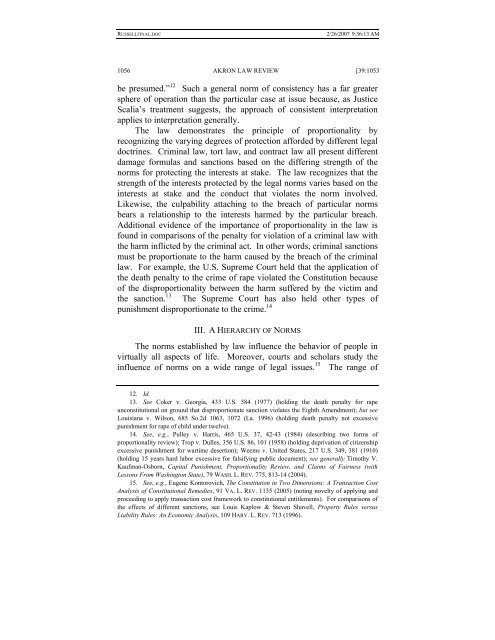THE LOGIC OF LEGAL REMEDIES AND THE RELATIVE WEIGHT ...
THE LOGIC OF LEGAL REMEDIES AND THE RELATIVE WEIGHT ...
THE LOGIC OF LEGAL REMEDIES AND THE RELATIVE WEIGHT ...
You also want an ePaper? Increase the reach of your titles
YUMPU automatically turns print PDFs into web optimized ePapers that Google loves.
RUSSELLFINAL.DOC<br />
2/26/2007 9:36:13 AM<br />
1056 AKRON LAW REVIEW [39:1053<br />
be presumed.” 12 Such a general norm of consistency has a far greater<br />
sphere of operation than the particular case at issue because, as Justice<br />
Scalia’s treatment suggests, the approach of consistent interpretation<br />
applies to interpretation generally.<br />
The law demonstrates the principle of proportionality by<br />
recognizing the varying degrees of protection afforded by different legal<br />
doctrines. Criminal law, tort law, and contract law all present different<br />
damage formulas and sanctions based on the differing strength of the<br />
norms for protecting the interests at stake. The law recognizes that the<br />
strength of the interests protected by the legal norms varies based on the<br />
interests at stake and the conduct that violates the norm involved.<br />
Likewise, the culpability attaching to the breach of particular norms<br />
bears a relationship to the interests harmed by the particular breach.<br />
Additional evidence of the importance of proportionality in the law is<br />
found in comparisons of the penalty for violation of a criminal law with<br />
the harm inflicted by the criminal act. In other words, criminal sanctions<br />
must be proportionate to the harm caused by the breach of the criminal<br />
law. For example, the U.S. Supreme Court held that the application of<br />
the death penalty to the crime of rape violated the Constitution because<br />
of the disproportionality between the harm suffered by the victim and<br />
the sanction. 13 The Supreme Court has also held other types of<br />
punishment disproportionate to the crime. 14<br />
III. A HIERARCHY <strong>OF</strong> NORMS<br />
The norms established by law influence the behavior of people in<br />
virtually all aspects of life. Moreover, courts and scholars study the<br />
influence of norms on a wide range of legal issues. 15 The range of<br />
12. Id.<br />
13. See Coker v. Georgia, 433 U.S. 584 (1977) (holding the death penalty for rape<br />
unconstitutional on ground that disproportionate sanction violates the Eighth Amendment); but see<br />
Louisiana v. Wilson, 685 So.2d 1063, 1072 (La. 1996) (holding death penalty not excessive<br />
punishment for rape of child under twelve).<br />
14. See, e.g., Pulley v. Harris, 465 U.S. 37, 42-43 (1984) (describing two forms of<br />
proportionality review); Trop v. Dulles, 356 U.S. 86, 101 (1958) (holding deprivation of citizenship<br />
excessive punishment for wartime desertion); Weems v. United States, 217 U.S. 349, 381 (1910)<br />
(holding 15 years hard labor excessive for falsifying public document); see generally Timothy V.<br />
Kaufman-Osborn, Capital Punishment, Proportionality Review, and Claims of Fairness (with<br />
Lessons From Washington State), 79 WASH. L. REV. 775, 813-14 (2004).<br />
15. See, e.g., Eugene Kontorovich, The Constitution in Two Dimensions: A Transaction Cost<br />
Analysis of Constitutional Remedies, 91 VA. L. REV. 1135 (2005) (noting novelty of applying and<br />
proceeding to apply transaction cost framework to constitutional entitlements). For comparisons of<br />
the effects of different sanctions, see Louis Kaplow & Steven Shavell, Property Rules versus<br />
Liability Rules: An Economic Analysis, 109 HARV. L. REV. 713 (1996).
















